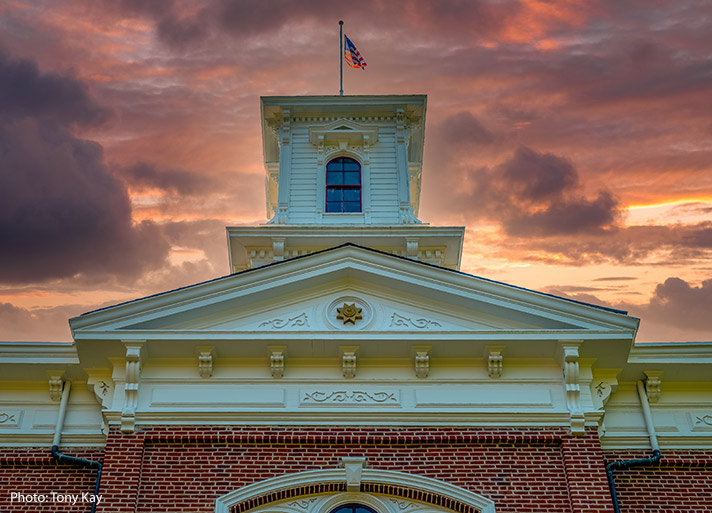A Few Minutes with the Mayor – September 2022
One of the most talked about topics over the past month has been Senate Bill (SB) 762. What is it? What does it mean? How does it affect my property? What should I do? Many Jacksonville property owners were shocked to receive form notices from the Oregon Department of Forestry (ODF) referring to SB 762, classifying their lands as either having extreme or high fire risk in a new Wildfire Risk Map. Then, on August 4th, 2022, ODF withdrew its newly created statewide Wildfire Risk Map and rescinded the notices to property owners in high and extreme risk zones and wildlife-urban zones. With some help from others, I will attempt to explain what we currently know about this new state law and its workings.
First, in 2021, the Oregon legislature passed Senate Bill 762 making vast changes to Oregon Wildfire Policy, affecting how the state responds to wildfires and potentially mandating rules that property owners must follow to lower the wildfire risks on their property. SB 762 moved wildfire control rules from local governments and spread them over four state agencies: the Oregon Department of Forestry (ODF), the Oregon State Fire Marshall (OSFM), the Oregon Department of Land Conservation and Development (DLCD), and the Oregon Department of Consumer and Business Services (DCBS). ODF then created a statewide map of every Oregon property parcel as the state’s map for all the state’s wildfire risk efforts. ODF classified every parcel in one of five wildfire risk classes: extreme, high, moderate, low, and no risk. The notices many of you received were for extreme or high-risk classes and, for many, caused confusion and concern. The notices offered ways of appealing the classification.
While ODF has removed its first Risk Map, a new mapping effort is in the works, with no current timing for completion. Appeals filed under the former map became moot but will be reviewed by ODF for informational purposes. ODF will then post the updated map on the Oregon State University Natural Resources Digital Library–Oregon Explorer, at www.oregonexplorer.info, (go to topics, all topics, then wildfire risk). At that point, new notices will be issued to property owners in the extreme and high-risk classifications, which will start a new appeal period. However, the map removal does not impact the development of wildfire rules by the OSFM and DCBS currently underway. The OSFM is creating rules for “defensible space” for structures on properties mapped as extreme or high risk. These rules will affect both new and existing development, including the authority to require the removal of vegetation, timber, and landscaping. The OSFM regulations, originally expected by December 31, 2022, are to be effective in 2023, we believe. See notes about proposed rules from the town hall meeting further down this column.
The DCBS, through their Building Codes Division, is in charge of new rules for the residential dwellings and accessory structures for high and extreme wildfire risk properties. These rules would require materials and construction techniques to make the structure more fire resistant and safer during wildfires. These rules will be enforced likely starting in April 2023.
The DLCD will enforce rules about development in high-risk, extreme risk, and wildland-urban interface areas.
Linda Davis, the Firewise Coordinator for the City of Jacksonville, reported on a recent town hall meeting she attended in Ashland, about the proposed defensible space and hardening rules. This meeting was conducted by Assistant Deputy State Fire Marshall Chad Hawkins. Some key elements of the proposed rules from the meeting were:
- The defensible space rules will be developed with input from many different stakeholders and community members. Defensible space includes removal of dead vegetation, limbing-up trees, and removing debris from pine needles and leaves on your roof and gutters. Defensible space applies to businesses and homes, where people live, eat, and shop. Its purpose is to decrease the loss of life.
- If your home is in the high or extreme risk class AND in the wildland-urban interface, no action is required related to home hardening (building materials and practices that can reduce the risk of ignition of a home by embers from wildfires). However, the defensible space rules apply if you are replacing a covered element such as a roof or siding or doing an addition to your home. You will need to use home hardening materials after April 1, 2023.
- If you are not in the high or extreme risk class OR are outside of the wildland-urban interface no action is required to home hardening, even after April 1, 2023.
- If your home is in a high-risk area, defensible space rules require you to create a 50-foot buffer from your home.
- If your home is in an extreme risk area, defensible space codes require you to create a 100-foot buffer from your home.
- Grants to property owners to help with defensible space projects were also discussed. In the winter of 2022, there will be $25 million in grants for Community Risk Reduction. They should be issued and available for grant applications in November or December 2022.
- The defensible space rules are focused on education. Enforcement is being discussed but we don’t know when that will happen.
Several questioned how home insurance rates would be increased for high or extreme-risk properties. It is clear that insurance companies need to be included in discussions of risk categories, defensible space, etc. It was also clear that most attending were unhappy with their risk designations.
As of now, Jacksonville has only such information as is available on various state websites. All Oregonians are in the same boat, with many unanswered questions and concerns. We will continue to monitor the new developments and keep you apprised of new information as it unfolds. We will publish news both on our city website, www.jacksonvilleor.us, our city newsletter included with your city services bill, and in the Jacksonville Review. A source for up-to-date information on the wildfire risk map is www.oregon.gov/odf/fire, under the Wildfire Risk category. Also, look for additional Town Hall Meetings to occur.
In the meantime, we have made a great start with wildfire issues within our city, especially with the new Jacksonville Comprehensive Safety Plan which debuted last summer. If you need a copy of the Emergency Evacuation Checklist and Map, please stop by City Hall. With outstanding participation, we have also successfully increased our Firewise neighborhoods in Jacksonville. We have increased awareness of the risks related to wildfires and as a result, have seen much of the hazardous material in town removed. Please contact our Firewise Coordinator Linda Davis at 541-690-5688 or lmdavis425@gmail.com for information on our Firewise program. An exciting fall event will be the re-opening of our new Jacksonville Fire Hall. Our fire department continues to fully operate temporarily, in a modular structure, next to the Public Works Department. We have advanced emergency operations and procedures in place, in the event of a wildfire and we will always do our best to protect everyone. Special thanks go to Councilor Steve Casaleggio and Firewise Coordinator Linda Davis for research on this column. We have tried to provide you with a lot of information, in a few words, about a complex issue. Since this has been a somewhat fluid experience, I expect new information to come out that is different than what we know at this time. We used information from various websites, information from the State of Oregon, and some first-hand experiences. Thank you for reading this column and I hope you enjoy the rest of the fire season, free of any danger from wildfire and smoke.

 Donna Bowen is the current Mayor of Historic Jacksonville, Oregon. Please contact Mayor Bowen with any topics you would be interested in hearing more about in this column at mayor@jacksonvilleor.us.
Donna Bowen is the current Mayor of Historic Jacksonville, Oregon. Please contact Mayor Bowen with any topics you would be interested in hearing more about in this column at mayor@jacksonvilleor.us.